| Oracle® Fusion Middleware Administrator's Guide for Oracle SOA Suite 11g Release 1 (11.1.1) Part Number E10226-02 |
|
|
View PDF |
| Oracle® Fusion Middleware Administrator's Guide for Oracle SOA Suite 11g Release 1 (11.1.1) Part Number E10226-02 |
|
|
View PDF |
This chapter introduces Oracle Business Activity Monitoring (Oracle BAM) configuration, and it explains how to configure Oracle BAM Server properties, Web applications properties, and distribution lists.
This chapter includes the following topics:
Section 21.3, "Configuring Oracle BAM Server Basic Properties"
Section 21.11, "Oracle BAM Configuration Property Reference"
Oracle BAM Server is the collection of the components Oracle BAM Active Data Cache (Oracle BAM ADC), Oracle BAM Report Cache, Oracle BAM Enterprise Message Sources (EMS), and Oracle BAM Event Engine.
The Oracle BAM Web applications are a collection of thin clients (Active Studio, Architect, Administrator, and Active Viewer) and Oracle BAM Report Server.
For more information about each of the subcomponents of Oracle BAM Server and Oracle BAM Web applications, see Oracle Fusion Middleware User's Guide for Oracle Business Activity Monitoring.
The most commonly used Oracle BAM Server and Web applications properties are configured in Oracle Enterprise Manager Fusion Middleware Control Console. See Section 21.3, "Configuring Oracle BAM Server Basic Properties" and Section 21.2, "Configuring Oracle BAM Web Basic Properties" for more information.
Security configuration is discussed in Section 21.9, "Configuring Security", and adding and managing Oracle BAM roles (permissions) and user accounts is discussed in Section 23.3, "Managing Oracle BAM Users."
Oracle User Messaging Service (UMS) must be configured so that alerts are delivered to Oracle BAM users. See Section 21.5, "Configuring Oracle User Messaging Service" for this information.
When using Oracle BAM in an SOA composite application, the Oracle BAM Adapter configuration must be completed. See Section 21.7, "Configuring Oracle BAM Adapter" for more information.
Advanced properties are located in configuration files that must be edited using the System MBean Browser. See Section 21.10, "Configuring Advanced Properties" for more information. Also, see Section 21.11, "Oracle BAM Configuration Property Reference" for a listing of all properties available for Oracle BAM configuration.
Oracle BAM distribution lists are used to send alerts and reports to multiple Oracle BAM users, rather than having to specify several individual recipients. Distribution lists are configured in the Oracle BAM Administrator application. See Section 21.6, "Configuring Oracle BAM Distribution Lists" for more information.
For performance tuning information for Oracle BAM, see Oracle Fusion Middleware Performance and Tuning Guide.
For Oracle BAM high availability configuration information, see Oracle Fusion Middleware High Availability Guide.
Some basic Oracle BAM Web applications properties are configured using Oracle Enterprise Manager Fusion Middleware Control Console.
Oracle BAM Web applications must be restarted when changes are made to any Oracle BAM properties. See Section 23.2, "Managing Oracle BAM Availability" for information about restarting Oracle BAM.
The following topics describe how to configure each property:
For information about configuring advanced properties, see Section 21.10, "Configuring Advanced Properties" and Section 21.11, "Oracle BAM Configuration Property Reference."
The Oracle BAM Web applications properties are configured in the OracleBamWeb Properties page in Fusion Middleware Control Console.
To configure Oracle BAM Web applications properties:
Go to the OracleBamWeb Properties page in Fusion Middleware Control Console by selecting the OracleBamWeb node.
Open Fusion Middleware Control Console in your Web browser at:
http://host_name:port_number/em
In the navigation tree, the Oracle BAM Web node is named OracleBamWeb in the BAM folder.
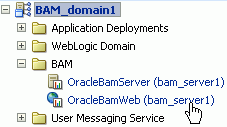
Select BAM Web Properties in the BAM Web menu.
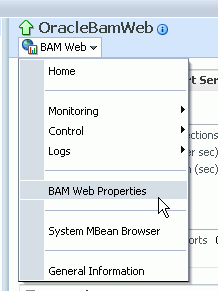
The BAM Web Properties page opens.
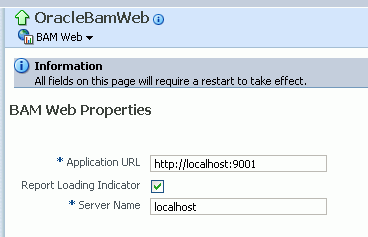
Enter the desired values in each of the fields provided.
See the following sections for information about configuring each of the properties:
Click Apply.
You must restart the Oracle BAM application after any property changes.
The Application URL property value must be updated from localhost to the actual host name to generate the correct URLs for reports and alerts.
The Application URL property is configured in both the Oracle BAM Web applications properties page and the Oracle BAM Server properties page. In Oracle BAM Web applications page, the URL is used to generate the full URL for reports and alerts.
Note that this property is common to both Oracle BAM Web applications and Oracle BAM Server. If it is configured on one page, the same value appears on the other configuration page.
The Report Loading Indicator property specifies whether the report loading indicator is enabled or disabled by default when viewing reports in Oracle BAM Active Studio and Oracle BAM Active Viewer.
With this property enabled, the report loading indicator is shown by default when a report is viewed; however, individual users can choose to disable the report loading indicator in their user preferences configuration. See Oracle Fusion Middleware User's Guide for Oracle Business Activity Monitoring for more information.
The Server Name property provides the host name of Oracle BAM Server. Oracle BAM Web applications are separate applications that require the location of Oracle BAM Server to get data from the Active Data Cache and Report Cache for the Oracle BAM Report Server.
Some basic Oracle BAM Server properties are configured using Oracle Enterprise Manager Fusion Middleware Control Console.
Oracle BAM Server must be restarted after any changes to Oracle BAM properties. See Section 23.2, "Managing Oracle BAM Availability" for information about restarting Oracle BAM.
The following topics describe how to configure each property:
Section 21.3.5, "Configuring Report Cache Persistence Manager"
Section 21.3.6, "Configuring Oracle Data Integrator Integration Properties"
For information about configuring advanced properties, see Section 21.10, "Configuring Advanced Properties" and Section 21.11, "Oracle BAM Configuration Property Reference."
Oracle BAM Server properties are configured in the OracleBamServer Properties page in Oracle Enterprise Manager Fusion Middleware Control Console.
To configure Oracle BAM Server properties:
Go to the Oracle BAM Server home page by selecting the OracleBamServer node in Fusion Middleware Control Console.
Open Fusion Middleware Control Console in your Web browser at:
http://host_name:port_number/em
In the navigation tree, the Oracle BAM Server node is named OracleBamServer, and it is found in the BAM folder.
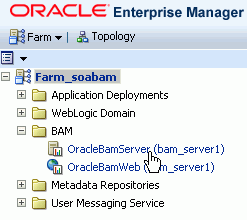
Select BAM Server Properties from the BAM Server menu.
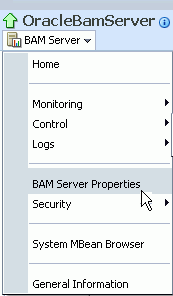
The BAM Server Properties page opens.
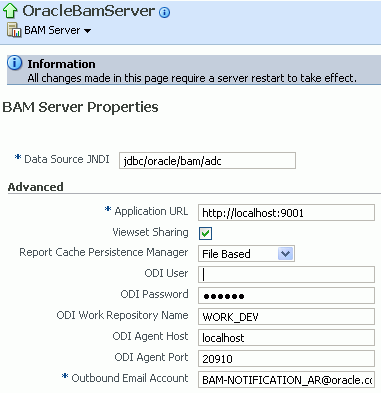
Enter the desired values in each of the fields provided.
See the following sections for information about configuring each of the properties:
Click Apply.
You must restart the Oracle BAM application after any property changes.
The Data Source JNDI property specifies the database used by Oracle BAM ADC. Enter the data source JNDI name created for Oracle BAM ADC. For general information about configuring data sources see Oracle Fusion Middleware Configuring and Managing JDBC for Oracle WebLogic Server
The Application URL property is used only by Oracle BAM Web applications. This configuration property is no longer used by Oracle BAM Server. See Section 21.2.2, "Configuring Application URL" for information about configuring this property for Oracle BAM Web applications.
The Viewset Sharing property enables viewset sharing when possible. A viewset is an object that represents a query to a given Oracle BAM data object. A viewset can include fields (which can be columns from the data object or lookups from other data objects), aggregates, groups, or calculated fields. A viewset can also be sorted, filtered, and row-level security is applied implicitly to it.
Typically, a particular viewset can be shared with other users if they are trying to access the same Oracle BAM dashboard, if the viewsets are not dissimilar due to factors such as row-level security, prompts or parameters used in filters, and so on.
A snapshot is a query result set that can be created by the viewset. Snapshots can be produced from a viewset after it is opened. Because snapshot generation is so performance-intensive, viewset sharing allows Oracle BAM Server to take only one snapshot of a given view to share across multiple users of the same dashboard.
Sharing viewsets between users of the same views improves performance, but requires that new users wait for viewsets to be synchronized as each new user begins sharing the viewset.
The first user who opens an Oracle BAM dashboard receives a new snapshot (which is cached) and immediately receives active data in real time. Changes for active data, called change lists, are cached.
When additional users open the same dashboard, they receive the cached snapshot that was generated for the first user, and they receive cached change lists (more rapidly than the first user) while the "Synchronizing Active Data" message is displayed.
By default, up to 50 change lists are cached, so if multiple users open a dashboard, secondary users must wait for up to 50 change lists to be sent to the dashboard before they begin receiving real-time active data.
The ElementsCountLimit property can be set to allow fewer change lists to be cached. See Section 21.11, "Oracle BAM Configuration Property Reference" for information about configuring advanced properties.
The Report Cache Persistence Manager property specifies the persistence location (file based or memory based). Select the appropriate persistence location for your Oracle BAM Report Cache.
The Oracle Data Integrator integration properties specify values for integrating Oracle Data Integrator with Oracle BAM Server.
Enter the appropriate values for the following properties:
ODI User: The user that executes the scenarios in Oracle Data Integrator.
ODI Password: The encoded Oracle Data Integrator password.
ODI Work Repository Name: The name of the Oracle Data Integrator work repository database.
ODI Agent Host: The IP address or host name of the server where the Oracle Data Integrator agent is running.
ODI Agent Port: The Transmission Control Protocol (TCP) port on which the Oracle Data Integrator agent is listening.
This section explains how to configure the e-mail address that appears in the From header of e-mail notifications sent by the Oracle BAM Event Engine.
The Outbound Email Account property on Oracle BAM Server must point to a dedicated e-mail account for delivering Oracle BAM alert notification e-mail messages and Oracle BAM report link e-mail messages.
If an Oracle BAM alert configured with a secondary action to send an e-mail notification fails on the primary action, this property must be configured with an e-mail address that Oracle UMS can access at run time. Creating a dedicated e-mail account for this purpose is recommended.
Note:
Administrators should not use personal e-mail accounts to test alerts, because Oracle UMS may delete e-mail notifications in the mail box and continue deleting messages as they arrive.To complete the configuration, you must configure the Oracle UMS usermessagingdriver-email driver. See Section 21.5, "Configuring Oracle User Messaging Service" for details.
Oracle BAM Event Engine has another configuration property, TimeoutPeriodToGetFailedStatusesInMins, which is the time interval for which the Event Engine waits after delivering an e-mail notification, to see if it receives any failure notification from Oracle UMS. The default value for this property is 10 minutes. If a failure notification does not arrive within this time, the Event Engine assumes that e-mail delivery was successful, and the failover action is discarded. Failure notifications arriving after this time are ignored by the Event Engine. See Section 21.11, "Oracle BAM Configuration Property Reference" for information about configuring TimeoutPeriodToGetFailedStatusesInMins.
Use the Log Configuration page to configure logging levels. For information about viewing the logs, see Section 22.6, "Monitoring Oracle BAM Logs." Also, see Section 3.4, "Configuring Log Files" and Oracle Fusion Middleware Administrator's Guide for general information about logging and log levels.
To open the Log Configuration page, right click the OracleBamServer node or OracleBamWeb node in the navigation tree and select Logs > Log Configuration as shown in Figure 21-1.
For each logger, select the desired notification level as shown in Figure 21-2.
Oracle User Messaging Service (UMS) must be configured properly in Fusion Middleware Control Console to send e-mail notifications when alerts are issued.
The UMS e-mail driver monitors the outbound e-mail account configured for Oracle BAM Server for any delivery failures, including rejected e-mails. E-mail delivery failure notifications are asynchronous, that is, there is no definite time within which e-mail rejection notification is received.
To configure the service:
Open Fusion Middleware Control Console in your Web browser at:
http://host_name:port_number/em
Go to the usermessagingdriver-email (User Messaging Email Driver) page in Fusion Middleware Control Console by expanding the User Messaging Service folder, then selecting the usermessagingdriver-email (bam_server1) node.
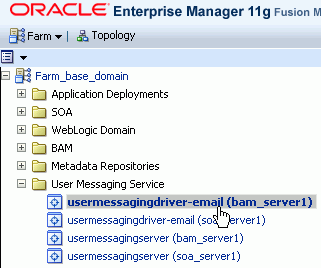
From the User Messaging Email Driver shortcut menu, select Email Driver Properties.
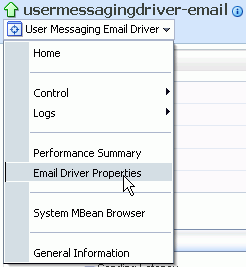
In the Driver-Specific Configuration section, the properties IncomingMailServer, IncomingUserIDs, and IncomingUserPasswords must be provided with the Internet Message Access Protocol (IMAP) server name (Oracle UMS also supports POP3), e-mail account name, and password to access this e-mail account.

See Section 24.4, "Configuring User Messaging Service Drivers" for more information. Table 24-4, "Custom E-Mail Properties" contains specific information about the properties you must configure.
Click Apply to save the changes.
Enter the e-mail account in the Outbound Email Account property in the Oracle BAM Server configuration. See Section 21.3.7, "Configuring Outbound Email Account" for details.
Oracle BAM distribution lists are used to send alerts and reports to multiple Oracle BAM users, rather than having to specify several individual recipients. Oracle BAM distribution lists are configured using the Oracle BAM Administrator application.
To configure distribution lists:
Go to the Oracle BAM start page, log in, and select Administrator.
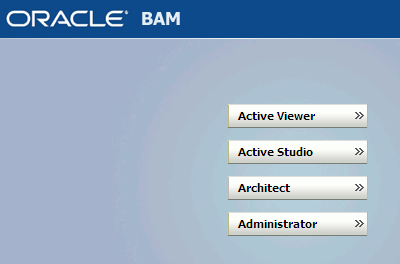
The Oracle BAM start page is located at:
http://host_name:port_number/OracleBAM/
Select Distribution List management from the list.
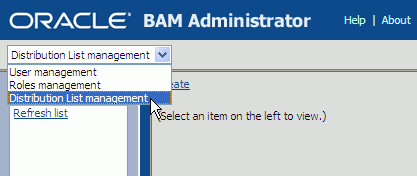
Click Create.
Enter a unique Distribution List Name and click Create.
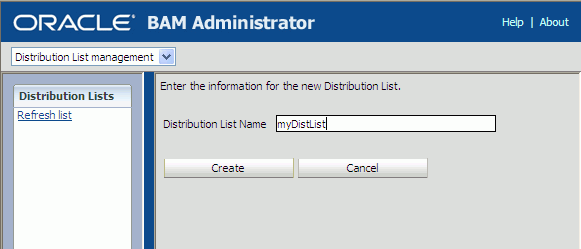
Click Continue to save the distribution list name.

Select the new distribution list that is displayed in the Distribution Lists list on the left side of the page, and click Edit.
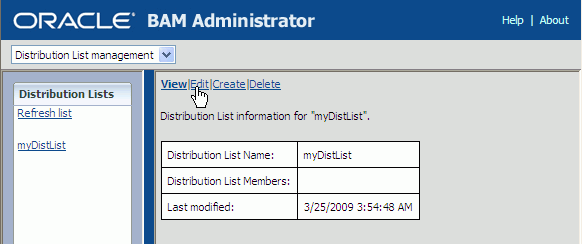
Select user accounts to add to the distribution list from the Select Members list.
You can select multiple users by clicking on several user names. The highlighted user names are added to the distribution list.
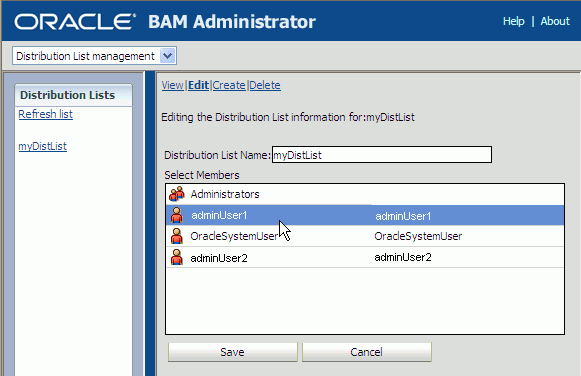
Click Save.
The users are added to the distribution list.
Oracle BAM Adapter properties, including the adapter batching properties, are configured in Oracle WebLogic Server Administration Console. See Section 21.7.1, "Configuring Oracle BAM Adapter Properties" for details.
Some issues that must be considered when Oracle BAM Adapter (including Oracle BAM sensor actions in a BPEL process) is used in an SOA composite application are configuring connection factories, trusted domains, and credential mapping.
Before deploying applications that use Oracle BAM Adapter, a connection factory to Oracle BAM Server must be configured. You can configure both Remote Method Invocation (RMI) and Simple Object Access Protocol (SOAP) connection factories. See Section 21.7.2, "Configuring Oracle BAM Connection Factories" for details.
When using the RMI connection between an SOA composite application and Oracle BAM Server, that is when they are deployed in different domains, trusted domain configuration must be done in Oracle WebLogic Server Administrative Console. See Section 21.7.3, "Configuring Trusted Domains" for more information.
If the Oracle BAM Adapter is using credentials rather than a plain text user name and password, in order for Oracle BAM Adapter (including Oracle BAM sensor actions in a BPEL process) to connect to Oracle BAM Server, the credentials must also be established and mapped. See Section 21.7.4, "Configuring Credential Mapping" for more information.
Notes:
Use plain text user names and passwords only in nonproduction mode. Do not mix using credential mapping and plain text user information; apply one at a time to avoid confusion.Because Oracle BAM and Oracle SOA Infrastructure use different identity stores, an Oracle BAM user must be configured in the service infrastructure identity store if there is not a common service infrastructure user and Oracle BAM user.
Oracle BAM Adapter does not support transactional behavior. Even though there is a section in Oracle WebLogic Server Administration Console for configuring transaction support, Oracle BAM Adapter must remain at the No Transaction level.
Oracle BAM Adapter properties are configured in Oracle WebLogic Server Administration Console.
To configure Oracle BAM Adapter properties:
Go to the Oracle WebLogic Server Administration Console (http://host_name:port_number/console), and log on.
In the Domain Structure menu, select Deployments.
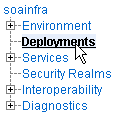
In the Deployments summary table, search for OracleBamAdapter and click it.
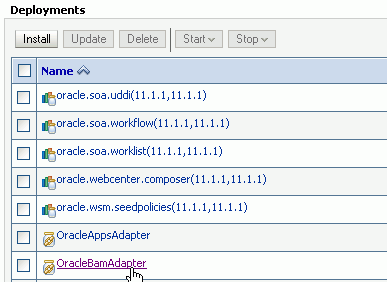
In the Settings for OracleBamAdapter page, select the Configuration tab, and then the Properties tab in the second row.
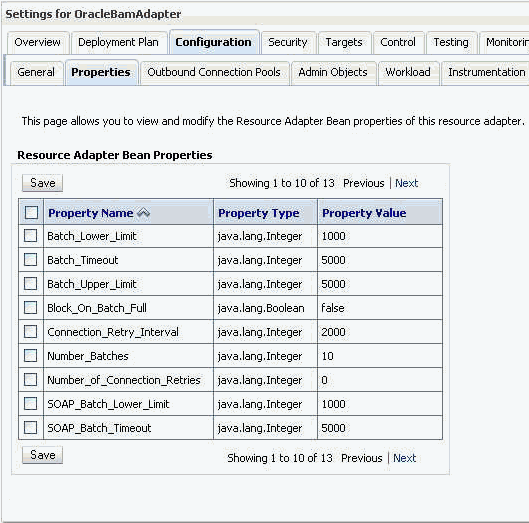
Enter the new values, select the checkboxes for each updated value, and click Save.
See Table 21-1, "Oracle BAM Adapter Configuration Properties" for information about each property.
Also, see Section 21.8, "Configuring Oracle BAM Batching Properties" for general information about configuring batching properties.
Note:
To commit these changes to the deployment plan you must click Activate Changes in the Change Center. If the Activate Changes button does not appear, see the Oracle BAM Troubleshooting Guide on the Oracle Technology Network web site for a workaround:http://www.oracle.com/technology/products/integration/bam/collateral/documentation.html
Restart the server.
Table 21-1 Oracle BAM Adapter Configuration Properties
| RMI Property | SOAP Property | Default | Description |
|---|---|---|---|
|
|
|
1000 |
The minimum amount of elements in a batch before it is sent out. |
|
|
|
5000 |
The maximum amount of elements in a batch before it is sent out. |
|
|
|
5000 |
The timeout in milliseconds after which the batch is sent out even if it is not full. |
|
|
|
true |
The default setting for block on batch full, which indicates whether batching operations should block when the batch is full. If |
|
|
|
10 |
The limit of the number of pending calls allowed. |
If messages from BPEL process monitors are published when Oracle BAM Server is unavailable, the messages are not persisted and therefore are not published to the Oracle BAM data objects when Oracle BAM Server comes back online.
You can change this behavior by setting the Oracle BAM Adapter property Block_On_Batch_Full to true in Oracle BAM Adapter configuration as described in Section 21.7.1, "Configuring Oracle BAM Adapter Properties."
For more information about BPEL process monitors see "Instrumenting BPEL Processes With Monitors" in Oracle Fusion Middleware Developer's Guide for Oracle SOA Suite.
Some configuration in the Oracle WebLogic Server Administration Console is necessary before using Oracle BAM Adapter.
Use the Oracle WebLogic Server Administration Console to configure the Oracle BAM connection factories for connections with Oracle BAM Server.
To configure Oracle BAM connection factories:
Go to the Oracle WebLogic Server Administration Console (http://host_name:port_number/console), and log on.
In the Domain Structure menu, select Deployments.

In the Deployments summary table, search for OracleBamAdapter and click it.

In the Settings for OracleBamAdapter page, select the Configuration tab, and then the Outbound Connection Pools tab in the second row.
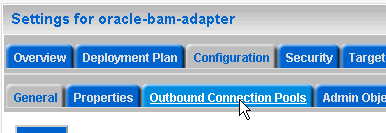
Configure the connection factory interface that you intend to use in Oracle JDeveloper, by expanding the appropriate Group and Instance target and clicking the Java Naming and Directory Interface (JNDI) name.
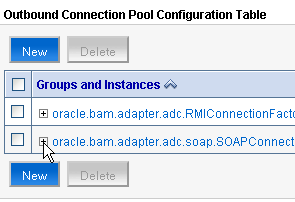
To configure the connection factory for RMI-based calls, click to expand the oracle.bam.adapter.adc.RMIConnectionFactory group and select the JNDI name that the user uses in Oracle JDeveloper. The eis/bam/rmi connection factory is provided out of the box.
To configure the connection factory for SOAP-based calls, click to expand the oracle.bam.adapter.adc.SOAPConnectionFactory group and select the JNDI name that the user uses in Oracle JDeveloper. The eis/bam/soap connection factory is provided out of the box.
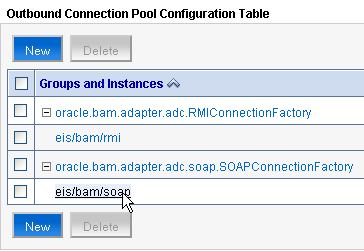
Configure each of the properties by clicking in the table cells and entering the values.
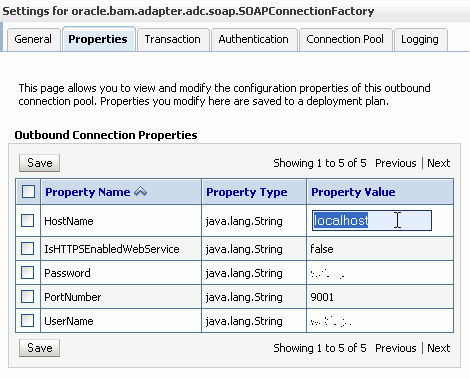
Note:
The UserName field should contain an Oracle BAM user who is a member of application-level role Administrator or Report Architect. See Section 23.3.3, "Adding Members to Application Roles" and Section 23.3.4, "Understanding Oracle BAM Application Roles" for information about assigning users to Oracle BAM application roles.This configuration creates the connection factory with HTTP. To configure an HTTPS connection factory, see Section 21.7.2.1, "Configuring HTTPS for Oracle BAM Adapter".
The RMI protocol has different configuration properties. You must provide InstanceName and IsClustered in addition to the standard connection properties.
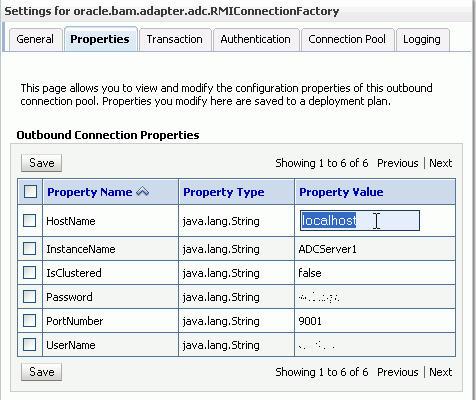
Select the checkboxes next to the values you have updated and click Save.
Note:
To commit these changes to the deployment plan you must click Activate Changes in the Change Center. If the Activate Changes button does not appear, see the Oracle BAM Troubleshooting Guide on the Oracle Technology Network web site for a workaround:http://www.oracle.com/technology/products/integration/bam/collateral/documentation.html
To configure HTTPS:
Locate the oracle.bam.adapter.adc.soap.SOAPConnectionFactory connection factory in the Oracle WebLogic Server Administration Console as described in Section 21.7, "Configuring Oracle BAM Adapter".

Click to expand the oracle.bam.adapter.adc.soap.SOAPConnectionFactory node, select the eis/bam/soap option, and click New.
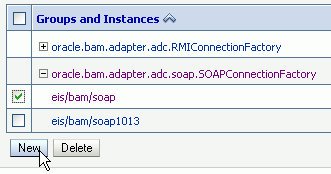
Select the oracle.bam.adapter.adc.soap.SOAPConnectionFactory option and click Next.
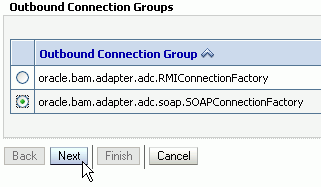
Enter a JNDI name for this connection factory and click Finish.

Select the eis/bam/https connection pool instance in the Groups and Instances list.
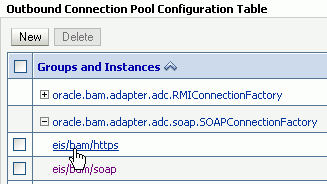
Complete the configuration properties as shown in Section 21.7, "Configuring Oracle BAM Adapter," and change the IsHTTPSEnabledWebService value to true.
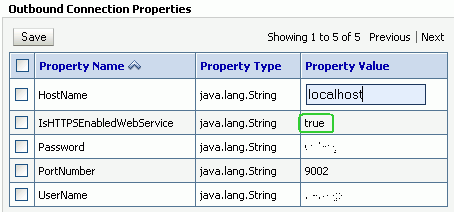
When using the RMI connection between an SOA composite application and Oracle BAM Server, that is when they are deployed in different domains, trusted domain configuration must be done in Oracle WebLogic Server Administrative Console.
To configure trusted domains:
Using the Oracle WebLogic Server Administration Console, in both SOA and Oracle BAM Server domains, go to base_domain > Security > General, and expand the Advanced settings.
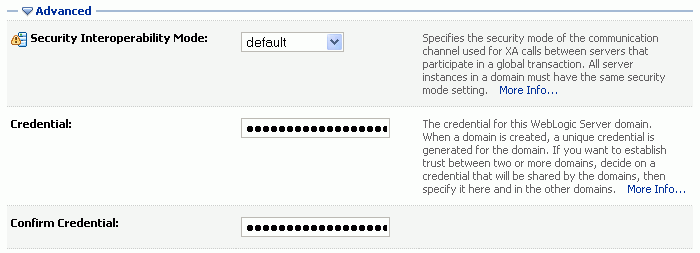
Enter the credential for the WebLogic Server domain in the Credential and Confirm Credential fields.
Enter the same credential in both the SOA and Oracle BAM Server domains to establish trust between the domains.
Save and Activate the changes, then restart Oracle WebLogic Server.
For more information about trusted domains see "Enabling Global Trust" in Oracle Fusion Middleware Securing Oracle WebLogic Server.
Configure Oracle BAM Adapter to securely store user name and password properties using Oracle WebLogic Server credential mapping functionality.
Note:
Use plain text user names and passwords only in nonproduction mode. Do not mix using credential mapping and plain text user information; apply one at a time to avoid confusion.To configure credential mapping:
Using the Oracle WebLogic Server Administration Console, go to Deployment > OracleBamAdapter > Security > Credential Mappings.

Click New and select an outbound connection pool instance for which to create a credential mapping entry, then click Next (By default, Oracle BAM is installed with two connection pools, eis/bam/rmi and eis/bam/soap).

Note:
Ensure that a separate credential mapping entry for each outbound connection pool is created. If there are any additional outbound connection pools other than the defaults, you must create corresponding credential mappings for them as well.Select Unauthenticated WLS User, and click Next (Unauthenticated WLS User is similar to an anonymous user).
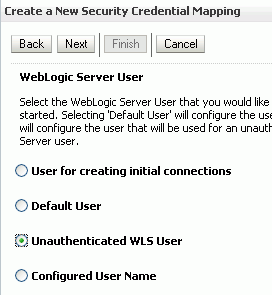
Specify a corresponding user name and password for connecting to Oracle BAM Server, then click Finish to complete the credential mapping.
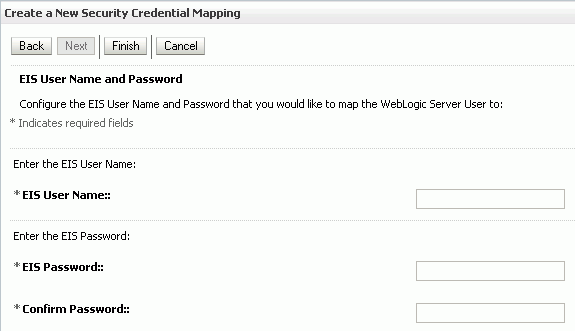
Repeat these steps to create the credential mapping for the other Oracle BAM connection pool entries.
After you configure the credential mappings for each of the outbound connection pool entries, the mappings appear in the Credential Mappings table.

For these changes to take effect, Oracle WebLogic Server must be restarted.
The batch processor batches operations (for example, insert, update, upsert, and delete) between the client and the Active Data Cache server to improve performance by limiting the number of remote calls. For example, 10 update operations could be processed in a single remote call with batching enabled, rather than making 10 remote calls.
Note:
Batching is used only on incoming data, not on internal Oracle BAM processes.Oracle BAM batching properties are located in the BAMCommonConfig.xml file at:
WLS_HOME/user_projects/domains/base_domain/config/fmwconfig/servers/bam_server1/applications/oracle-bam_11.1.1/config/
Oracle BAM must be restarted after any changes to Oracle BAM properties. See Section 23.2, "Managing Oracle BAM Availability" for information about restarting Oracle BAM.
Table 21-2 Active Data Cache API and SOAP (Oracle BAM Adapter) Batching Properties
| Oracle BAM ADC API Property | SOAP Property | Default | Description |
|---|---|---|---|
|
ActiveDataCache_Datasets_Batching_Limit_PendingCalls |
Adapter_SOAP_Batching_Limit_PendingCalls |
10 |
The limit of the number of pending calls allowed. |
|
ActiveDataCache_Datasets_Batching_Limit_Lower |
Adapter_SOAP_Batching_Limit_Lower |
1000 |
The minimum number of elements in a batch before it is sent out. |
|
ActiveDataCache_Datasets_Batching_Limit_Upper |
Adapter_SOAP_Batching_Limit_Upper |
5000 |
The maximum number of elements in a batch before it is sent out. |
|
ActiveDataCache_Datasets_Batching_Timeout |
Adapter_SOAP_Batching_Timeout |
5000 |
The timeout interval in milliseconds after which the batch is sent out even if it is not full. |
|
ActiveDataCache_Datasets_Batching_FlushOnDemand_Limit |
Adapter_SOAP_Batching_FlushOnDemand_Limit |
1000 |
The number of rows to take into a batch when flushing on demand. |
|
ActiveDataCache_Datasets_Batching_RetryInterval |
Adapter_SOAP_Batching_RetryInterval |
30000 |
The interval in milliseconds at which batch processing should attempt to retry failed flush attempts. |
|
ActiveDataCache_Datasets_Batching_MaxRetryInterval |
Adapter_SOAP_Batching_MaxRetryInterval |
3600000 |
The maximum interval in milliseconds at which batch processing should attempt to retry failed flush attempts. |
|
ActiveDataCache_Datasets_Batching_MaximumRetries |
Adapter_SOAP_Batching_MaximumRetries |
|
The maximum number of times batch processing should attempt to retry failed flush attempts. Zero indicates no retry. |
|
ActiveDataCache_Datasets_Batching_SuspendOnDisconnect |
Adapter_SOAP_Batching_SuspendOnDisconnect |
|
Suspend on disconnect, which indicates whether batching operations should be permanently suspended if and when the connection to Oracle BAM Server is lost. |
Batching Retry Mechanism
The batching retry mechanism is designed to retry remote calls to the server in the event communication with the server is lost due to, for example, network problems or Oracle BAM Server going offline. The operation of this retry mechanism is governed by the configuration properties detailed in this section. The term flush refers to the attempt to send the batch calls to the Oracle BAM Server for processing.
The RetryInterval property specifies the interval between retry attempts in milliseconds. If the MaxRetryInterval value is unspecified (0), then the code continues retrying at the RetryInterval value until the batch flush is successful or the MaximumRetries value is exceeded.
If the MaxRetryInterval value is specified, then the retry interval value is doubled on each retry up to the MaxRetryInterval value. It stays at the MaxRetryInterval rate until the batch flush is successful, or the MaximumRetries value is exceeded. This allows the retry rate to decline over time to a more reasonable long-term rate. If the server does not recover quickly, do not continue to retry at a rapid rate.
If the MaximumRetries value is 0, then no retries are attempted and failed batches are discarded.
If the SuspendOnDisconnect value is true, then all batching is permanently suspended until the client application is restarted, regardless of whether communication with Oracle BAM Server is reestablished.
If the pending batch limit is reached and the current batch is full (maximum size reached), then batch calls are blocked. There is no place to queue the operation from the current call, so Oracle BAM blocks the client until the condition resolves itself.
Table 21-2 describes the configuration properties that can be specified for the Active Data Cache API batching (which is used by the RMI connection factory, configured in Section 21.7.2, "Configuring Oracle BAM Connection Factories").
The Oracle BAM Adapter batching mechanism (used by the SOAP connection factory) has an identical set of configuration properties and default values.
Security is configured in Oracle WebLogic Server. See Oracle Fusion Middleware Securing Oracle WebLogic Server for information about the topics listed in this section.
General information about Oracle WebLogic Server security is available in Oracle Fusion Middleware Understanding Security for Oracle WebLogic Server.
This section address the following security topics as they relate to Oracle BAM:
Credential mapping is used to securely store user name and password properties when using the Oracle BAM Adapter. For information see Section 21.7.4, "Configuring Credential Mapping."
To provide secure access to the Oracle BAM applications, users are assigned to roles that provide the necessary permissions. See Section 23.3, "Managing Oracle BAM Users" for more information.
Oracle WebLogic Server provides the facilities needed to enable Secure Socket Layer (SSL) on any Oracle SOA Suite and Oracle WebCenter connections into Oracle WebLogic Server.
Use the Java Development Kit (JDK) keytool utility to create and manage keystores and certificates, and use the Oracle WebLogic Server Administration Console to configure Oracle WebLogic Server listeners.
See "Configuring SSL" in Oracle Fusion Middleware Securing Oracle WebLogic Server for more information.
Although Oracle WebLogic Server lets you configure the Oracle BAM Web applications on both SSL and non-SSL ports, and Oracle BAM can also be configured to run on both SSL and non-SSL ports, it causes issues with the URL configured for Oracle BAM alerts. When Oracle BAM is running on both SSL and non-SSL ports, it cannot send two Oracle BAM report URLs to the alert e-mail receiver. It is the responsibility of the administrator to decide which mode of access (SSL or non-SSL) to use for the Oracle BAM report URL recipients.
To start Oracle BAM in SSL mode, and enable Oracle BAM clients (like ICommand) to invoke Oracle BAM ADC, invoke EJBs, JMS resources, and JDBC resources using SSL, you must configure the following Oracle BAM properties:
Communication_Protocol in the BAMCommonConfig.xml, BAMServerConfig.xml, and BAMICommandConfig.xml files, as follows:
Default value: <Communication_Protocol>t3</Communication_Protocol>
For SSL using t3s: <Communication_Protocol>t3s</Communication_Protocol>
ListenPort in BAMCommonConfig.xml file, as follows:
Default value: <ListenPort>ListenPort</ListenPort>
For SSL: <ListenPort>SSLListenPort</ListenPort>
For general information about configuring Oracle Internet Directory, see "Configuring Users and Groups in the Oracle Internet Directory and Oracle Virtual Directory Authentication Providers" in Oracle Fusion Middleware Securing Oracle WebLogic Server.
To use Oracle Internet Directory with Oracle BAM:
Configure Oracle Internet Directory using the Oracle WebLogic Server Administration Console.
Create OracleSystemUser in Oracle Internet Directory, by connecting to Oracle Internet Directory with an Lightweight Directory Access Protocol (LDAP) browser and creating a user in the same base user Distinguished Name that was provided in the Oracle WebLogic Server Administration Console while configuring Oracle Internet Directory.
Run the following SQL statements to null the user global unique identifiers (GUID) in the Oracle BAM schema:
UPDATE "SysIterUser" SET "SysIterUser"."GUID" = NULL, "SysIterUser"."Inactive" = NULL;
Oracle BAM provides many advanced properties not available for configuration using the OracleBamServer and OracleBamWeb properties pages in Fusion Middleware Control Console. These advanced properties are configured using the System MBean Browser.
See Section 21.11, "Oracle BAM Configuration Property Reference" for a listing of all properties available for Oracle BAM configuration.
To configure the advanced properties using the System MBean Browser:
Select System MBean Browser in the OracleBAMWeb or OracleBAMServer menu.
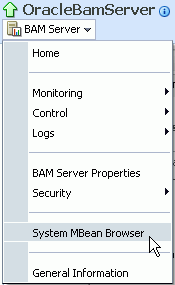
Select the path to the appropriate Application Defined MBeans page:
For properties common to all Oracle BAM components select Application Defined MBeans > oracle.bam.common > Server: bam_server1 > Application: oracle-bam > Config > BAMCommonConfig (see Figure 21-3).
For Oracle BAM Server-specific properties select Application Defined MBeans > oracle.bam.server > Server: bam_server1 > Application: oracle-bam > Config > BAMServerConfig.
For Oracle BAM Web applications-specific properties select Application Defined MBeans > oracle.bam.web > Server: bam_server1 > Application: oracle-bam > Config > BAMWebConfig.
Figure 21-3 System MBean Browser Navigation Tree
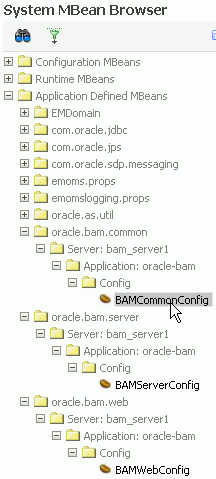
The associated configuration properties are displayed in the System MBean Browser.
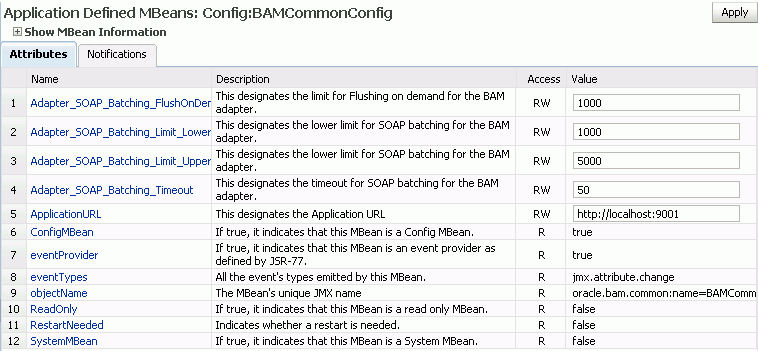
Edit property values in the Values column, and click Apply.
Oracle BAM must be restarted after any changes to Oracle BAM properties. See Section 23.2, "Managing Oracle BAM Availability" for information about restarting Oracle BAM.
Oracle BAM Configuration Property Files
All Oracle BAM properties are located in configuration files. These files are located in the following directory on the host where the Oracle BAM components are installed:
WLS_HOME/user_projects/domains/base_domain/config/fmwconfig/servers/bam_server1/applications/oracle-bam_11.1.1/config
The configuration properties usually go into the BAMCommonConfig.xml file, which contains the properties global to all Oracle BAM components. These properties can also be specified in component specific configuration files:
Oracle BAM Server-specific properties are configured in BAMServerConfig.xml
Oracle BAM Web applications-specific properties are configured in BAMWebConfig.xml
Oracle BAM ICommand utility-specific properties are configured in BAMICommandConfig.xml
The properties set in the BAMCommonConfig.xml file are always loaded. Any additional configuration files must be loaded explicitly. Oracle BAM Server explicitly loads the BAMServerConfig.xml file, the Oracle BAM Web applications explicitly load the BAMWebConfig.xml file, and ICommand explicitly loads the BAMICommandConfig.xml file. When a configuration file is loaded, its properties override any properties previously set, that is properties specified in BAMServerConfig.xml override properties set in BAMCommonConfig.xml.
This section provides a brief description of each Oracle BAM configuration property that may be used.
Advanced properties are configured in the Fusion Middleware Control Console System MBean Browser. See Section 21.10, "Configuring Advanced Properties" for information about configuring properties that do not appear in the Oracle BAM configuration pages in Fusion Middleware Control Console.
Table 21-3 Oracle BAM Configuration Properties
| Property Name | Description |
|---|---|
|
ActiveDataCache.API.Batching.ThreadPool.CoreSize |
Indicates how many threads to keep in the Oracle BAM ADC API ThreadPools when idle. Default: 5 |
|
ActiveDataCache.API.Batching.ThreadPool.KeepAliveTimeInSecs |
Amount of time (in seconds) to keep an idle thread in the Oracle BAM ADC API ThreadPools. Default: 20 |
|
ActiveDataCache.API.Batching.ThreadPool.MaxSize |
Maximum number of threads in the Oracle BAM ADC API ThreadPools. Default: 100 |
|
ActiveDataCache.API.Batching.ThreadPool.QueueSize |
Maximum number of messages that can be queued in the Oracle BAM ADC API ThreadPools. Default: 30 |
|
ActiveDataCache.API.BufferedDataReader.ThreadPool.CoreSize |
Indicates how many threads to keep in the Oracle BAM ADC BufferedDataReader ThreadPools when idle. Default: 10 |
|
ActiveDataCache.API.BufferedDataReader.ThreadPool.KeepAliveTimeInSecs |
Configured in BAMCommonConfig.xml Amount of time (in seconds) to keep an idle thread in the Oracle BAM ADC BufferedDataReader ThreadPools. Default: 20 |
|
ActiveDataCache.API.BufferedDataReader.ThreadPool.MaxSize |
Maximum number of threads in the Oracle BAM ADC BufferedDataReader ThreadPools. Default: 100 |
|
ActiveDataCache.API.BufferedDataReader.ThreadPool.QueueSize |
Maximum number of messages that can be queued in the Oracle BAM ADC BufferedDataReader ThreadPools. Default: 30 |
|
ActiveDataCache.Kernel.ActiveDataQueue.ThreadPool.CoreSize |
Indicates how many threads to keep in the Oracle BAM ADC ActiveDataQueue ThreadPools when idle. Default: 20 |
|
ActiveDataCache.Kernel.ActiveDataQueue.ThreadPool.KeepAliveTimeInSecs |
Amount of time (in seconds) to keep an idle thread in the Oracle BAM ADC ActiveDataQueue ThreadPools. Default: 20 |
|
ActiveDataCache.Kernel.ActiveDataQueue.ThreadPool.MaxSize |
Maximum number of threads in the Oracle BAM ADC ActiveDataQueue ThreadPools. Default: 100 |
|
ActiveDataCache.Kernel.ActiveDataQueue.ThreadPool.QueueSize |
Maximum number of messages that can be queued in the Oracle BAM ADC ActiveDataQueue ThreadPools. Default: 30 |
|
ActiveDataCache_Datasets_Batching_FlushOnDemand_Limit |
Number of rows to include in a batch when flushing on demand. See Section 21.8, "Configuring Oracle BAM Batching Properties" for more information. Default: 1000 |
|
ActiveDataCache_Datasets_Batching_Limit_Lower |
The minimum amount of elements in a batch before it is sent to the server. Depending on the load, batches may contain more than this minimum (up to the maximum) but will never contain less than this minimum (unless the timeout expires). See See Section 21.8, "Configuring Oracle BAM Batching Properties" for more information. Default: 1000 |
|
ActiveDataCache_Datasets_Batching_Limit_PendingCalls |
The limit of the number of pending batches that are waiting to be sent to the server. When this limit is reached and the current batch is full (at its upper limit), further batched operations become blocking calls until this condition is cleared. This limit throttles the client and keeps it from overrunning the server. See Section 21.8, "Configuring Oracle BAM Batching Properties" for more information. Default: 10 |
|
ActiveDataCache_Datasets_Batching_Limit_Upper |
The maximum amount of elements in a batch before it is sent out. A batch will never contain more than this maximum. See Section 21.8, "Configuring Oracle BAM Batching Properties" for more information. Default: 5000 |
|
ActiveDataCache_Datasets_Batching_MaximumRetries |
The maximum number of times batch processing retries failed attempts to send the batch to the server. A value of 0 (zero) indicates no retry. Default: 2147483647 |
|
ActiveDataCache_Datasets_Batching_MaxRetryInterval |
The maximum interval in milliseconds at which batch processing retries failed attempts to send the batch to the server. If this maximum retry interval is specified, the retry interval will be doubled on each retry attempt until the interval reaches this maximum value. Further retries will use this maximum value. This enables the configuration of retry attempts that will taper off should the failure not resolve itself quickly. If a maximum retry interval of 0 (zero) is specified, the retry interval will not change. Default: 3600000 |
|
ActiveDataCache_Datasets_Batching_RetryInterval |
The interval in milliseconds at which batch processing retries failed attempts to send the batch to the server. Retry is attempted when the failure is due to server connectivity problems such as the server being restarted. Default: 30000 |
|
ActiveDataCache_Datasets_Batching_SuspendOnDisconnect |
Indicates whether batching operations are permanently suspended if and when the connection to Oracle BAM server is lost. Default: |
|
ActiveDataCache_Datasets_Batching_ThreadPoolSize |
The constant size thread pool (that is, containing a fixed number of threads). Default: 25 |
|
ActiveDataCache_Datasets_Batching_Timeout |
The time-out in milliseconds after which the batch is sent out even if it is not full (has less than the configured minimum in The time-out ensures that operations are not waiting overlong in a batch due to inactivity. A batched operation will never wait longer than this time-out to be sent to the server. See Section 21.8, "Configuring Oracle BAM Batching Properties" for more information. Default: 50 |
|
Adapter_SOAP_Batching_FlushOnDemand_Limit |
Number of rows to include in a batch when flushing on demand. See Section 21.8, "Configuring Oracle BAM Batching Properties" for more information. Default: 1000 |
|
Adapter_SOAP_Batching_Limit_Lower |
The minimum amount of elements in a batch before it is sent out. See Section 21.8, "Configuring Oracle BAM Batching Properties" for more information. Default: 1000 |
|
Adapter_SOAP_Batching_Limit_Upper |
The maximum amount of elements in a batch before it is sent out. See Section 21.8, "Configuring Oracle BAM Batching Properties" for more information. Default: 5000 |
|
Adapter_SOAP_Batching_Timeout |
The timeout interval in milliseconds after which the batch is sent out even if it is not full. See Section 21.8, "Configuring Oracle BAM Batching Properties" for more information. Default: 50 |
|
ADC_PassThrough_Import_BatchSize |
The maximum number of rows that are imported from an external data object. Default: 50 |
|
ADC_PassThrough_Import_MaxRowsToImportAtOnce |
Maximum number. of rows imported by Default: 100 |
|
ADC_PassThrough_Import_MaxSize |
Maximum size imported by Default: -1 |
|
ADCBatchSize |
Refers to JDBC statement batching. When the Oracle BAM ADC executes SQL statements it uses JDBC batching to reduce the number of calls to the database, improving performance. Each call executes a batch of statements rather than a single statement. Default: 100 |
|
ADCChannelName |
This property is for Oracle BAM internal use only. Do not change it unless instructed to do so by Oracle Support Services. Default: |
|
ADCDataSource |
The data source for the Active Data Cache. See Section 21.3.2, "Configuring Data Source JNDI" for more information. Default: |
|
ADCLogBatchInsertLocks |
Indicates whether to log Oracle BAM ADC batch insert locks. Default: false |
|
ADCLogFolderLocks |
Indicates whether to log Oracle BAM ADC folder locks. Default: false |
|
ADCLogSqlStatements |
Indicates whether to log Oracle BAM ADC SQL statements. Default: false |
|
ADCLogTransactionLocks |
Indicates whether to log Oracle BAM ADC transaction locks. Default: false |
|
ADCMaxViewsetRowCount |
The default limit for rows of data displayed in a view with this property. Note that the higher you set this value, the more performance is impacted. Default: 64000 |
|
ADCPreloadDataObjectIDs |
Indicates whether data objects should be loaded at Oracle BAM ADC startup rather than on-demand as they are accessed. Pre-loading the data objects increases startup time but decreases initial data object access time. Not pre-loading the data objects decreases startup time but increases initial data object access time. Also, pre-loading all data objects where many data objects are rarely referenced may needlessly increase memory requirements. |
|
ADCPushInterval |
The rate at which Oracle BAM Active Data Cache pushes events to Oracle BAM Report Server. This is one factor that affects the frequency at which active events occur on Oracle BAM dashboard pages. Increasing this interval reduces the load on Oracle BAM Server. However, larger intervals increase the likelihood of multiple updates in the dashboard being collapsed into single updates. Note that you can override the default Default: 1000 |
|
ADCPushThreadPoolSize |
Indicates the size of the threadpool for Oracle BAM ADC push functionality. Default: 10 |
|
ADCRetryCount |
Number of times to retry the Oracle BAM Active Data Cache connection. Default: 2 |
|
ADCSecurityFiltersEnabled |
Indicates whether Oracle BAM ADC security filters are to be enabled. Default: true |
|
ADCServerName |
Host name of Oracle BAM Server. Oracle Data Integrator uses this property as an Oracle BAM connection parameter. Default: localhost |
|
ADCServerPort |
Port used by Oracle BAM Server. Oracle Data Integrator uses this property as an Oracle BAM connection parameter. Default: 7001 |
|
ADCViewsetTimeoutSec |
Specifies the time-out for retrieving a viewset. Default: 0 |
|
ADCWaitTime |
Interval between Active Data Cache connection attempts. Default: 20 |
|
ApplicationURL |
URL for Oracle BAM Web applications and Oracle BAM Server. See Section 21.3.3, "Configuring Application URL" and Section 21.2.2, "Configuring Application URL" for more information. Default: |
|
Architect_Content_PageSize |
Controls how many rows are shown when viewing data object contents in Oracle BAM Architect. Default: 100 |
|
AutoIncrementBlockSize |
Indicates amount of increment for block size. Default: 100 |
|
CacheDirectory |
Designates the directory used by Report Cache to cache snapshots and active data. Default: |
|
ChangeListDelay |
This property is for Oracle BAM internal use only. Do not change it unless instructed to do so by Oracle Support Services. Default: 1 |
|
ChannelName |
This property is for Oracle BAM internal use only. Do not change it unless instructed to do so by Oracle Support Services. Default: OracleBAM |
|
CheckViewsFallingBehindInterval |
Indicates the interval to check whether views are falling behind. Default: 20 |
|
CollaborationNILogin |
Whether NI Login is used. Default: false |
|
ColumnarTimeout |
Indicates the columnar time-out. Default: 0 |
|
Communication_Protocol |
Specifies the communication protocol for EJB. For SSL using t3: See Section 21.9.3, "Configuring Secure Socket Layer." Default: t3 |
|
ConnectionFactoryName |
This property is for Oracle BAM internal use only. Do not change it unless instructed to do so by Oracle Support Services. Default: jms/QueueConnectionFactory |
|
DeletesActiveDataSize |
InsertsActiveDataSize, UpdatesActiveDataSize, UpsertsActiveDataSize, DeletesActiveDataSize determine how many inserts, updates, upserts, and deletes, respectively, should be executed before releasing and then requiring the lock on the data object being modified. This keeps the operation from holding the data object lock for long periods of time when there are Viewsets open on this data object. Default: 50 |
|
DisplayUIStackTrace |
This property is for Oracle BAM internal use only. Do not change it unless instructed to do so by Oracle Support Services. This property enables user interface stack traces (by setting this property value to Default: false |
|
DistributionListGroupType |
This property is for Oracle BAM internal use only. Do not change it unless instructed to do so by Oracle Support Services. Default: none |
|
ElementsCountLimit |
The number of change lists that are cached before rewriting the cache file. The default value is 50. When the 51st change list is received, it is cached by replacing the 1st change list. Default: 50 |
|
ElementsSizeLimit |
This property is for Oracle BAM internal use only. Do not change it unless instructed to do so by Oracle Support Services. Default: 500 |
|
EmailIDForSender |
E-mail address that appears in the From header of notifications sent by the Event Engine. See Section 21.3.7, "Configuring Outbound Email Account" for more information. Default: |
|
EMSConnectionRecoveryDuration |
This property is for Oracle BAM internal use only. Do not change it unless instructed to do so by Oracle Support Services. |
|
EnableADCDatasetLockTimeout |
This property is for Oracle BAM internal use only. Do not change it unless instructed to do so by Oracle Support Services. Indicates whether data set lock timeout is enabled. Default: false |
|
EnableDataTruncationMsg |
Indicates whether to enable the data truncation message. Default: false |
|
EnableGetAllViewsInOneRoundTrip |
Allows all views to be retrieved in one round trip. Default: true |
|
EventEngine.Action.ThreadPool.CoreSize |
Indicates how many threads to keep in the Event Engine Action ThreadPools when idle. Default: 4 |
|
EventEngine.Action.ThreadPool.KeepAliveTimeInSec |
Amount of time (in seconds) to keep an idle thread in the Event Engine Action ThreadPools. Default: 20 |
|
EventEngine.Action.ThreadPool.MaxSize |
Maximum number of threads in the Event Engine Action ThreadPools. Default: 100 |
|
EventEngine.Action.ThreadPool.QueueSize |
Maximum number of messages that can be queued in the Event Engine Action ThreadPools. Default: 4 |
|
EventEngine.AlertHistory.ThreadPool.CoreSize |
Indicates how many threads to keep in the Event Engine AlertHistory ThreadPools when idle. Default: 4 |
|
EventEngine.AlertHistory.ThreadPool.KeepAliveTimeInSecs |
Amount of time (in seconds) to keep an idle thread in the Event Engine Action ThreadPools. Default: 20 |
|
EventEngine.AlertHistory.ThreadPool.MaxSize |
Maximum number of threads in the Event Engine AlertHistory ThreadPools. Default: 100 |
|
EventEngine.AlertHistory.ThreadPool.QueueSize |
Maximum number of messages that can be queued in the Event Engine RuleFire ThreadPools. Default: 10 |
|
EventEngineAlertHistoryEventLogging |
This property is for Oracle BAM internal use only. Do not change it unless instructed to do so by Oracle Support Services. Default: false |
|
EventEngineAlertHistoryRecordsPerWrite |
This property is for Oracle BAM internal use only. Do not change it unless instructed to do so by Oracle Support Services. Default: 10 |
|
EventEngine.RuleFire.ThreadPool.CoreSize |
Indicates how many threads to keep in the Event Engine RuleFire ThreadPools when idle. Default: 4 |
|
EventEngine.RuleFire.ThreadPool.KeepAliveTimeInSecs |
Amount of time (in seconds) to keep an idle thread in the Event Engine RuleFire ThreadPools. Default: 20 |
|
EventEngine.RuleFire.ThreadPool.MaxSize |
Maximum number of threads in the Event Engine RuleFire ThreadPools. Default: 100 |
|
EventEngine.RuleFire.ThreadPool.QueueSize |
Maximum number of messages that can be queued in the Event Engine RuleFire ThreadPools. Default: 4 |
|
EventEngineCheckADCIntervalSecs |
This property is for Oracle BAM internal use only. Do not change it unless instructed to do so by Oracle Support Services. Default: 5 |
|
EventEngineMaxConnections |
This property is for Oracle BAM internal use only. Do not change it unless instructed to do so by Oracle Support Services. Default: 25 |
|
EventEngineMaxShutdownWaitInterval |
This property is for Oracle BAM internal use only. Do not change it unless instructed to do so by Oracle Support Services. Default: 10 |
|
EventEngineSaveLastFireIntervalSecs |
This property is for Oracle BAM internal use only. Do not change it unless instructed to do so by Oracle Support Services. Default: 10 |
|
FileHandleCacheSize |
Used by Oracle BAM Report Cache to cache file handles of the files used for caching when file-based persistence is used (see Section 21.3.5, "Configuring Report Cache Persistence Manager" for information about persistence management). Handle caching increases the speed of reading and writing active data and snapshots. Each viewset has two file handles--one for the snapshot and another for active data. The value for this property sets the number of file handles that are cached by default. To disable file handle caching, set this property value to zero (0). The cost of file handle caching is that all of the cached file handles remain open, and so a) on servers configured for a very small number of concurrent open file handles, and b) on servers heavily loaded with open file handle count reaching the maximum value, this could create a problem. For these scenarios, reduce Default: 100 |
|
GenericSatelliteChannelName |
This property is for Oracle BAM internal use only. Do not change it unless instructed to do so by Oracle Support Services. Default: |
|
GenericSatelliteSystemObjectNames |
This property is for Oracle BAM internal use only. Do not change it unless instructed to do so by Oracle Support Services. Default values:
|
|
HelpAppLocation |
This property is no longer used in Oracle BAM. |
|
iActiveDataCloseReportsTimeout |
Timeout to close reports. Default: 500 |
|
iActiveDataMaxDiffCounter |
The maximum difference counter for iActiveData. Default: 10 |
|
iActiveDataMinIntervalsToWait |
The minimum interval to wait for iActiveData. Default: 5 |
|
iActiveDataReloadOnSecsBehindThreshold |
The threshold value for reloading iActiveData. The Default: 10 |
|
iActiveDataRestartInterval |
The restart interval for iActiveData. Default: 3000 |
|
iActiveDataRestartTimeout |
The restart timeout value for iActiveData. Default: 10000 |
|
iActiveDataScriptsCleanupFactor |
A property to address a Microsoft Internet Explorer memory leak, when active data is coming into the dashboard at a fast pace, by forcing periodic browser refreshes. This value may be further increased when active data is coming to the dashboard at a rate of 25 events per second or greater. You can monitor the Microsoft Internet Explorer memory consumption to determine an appropriate value. Default: 1048576 |
|
ICommand_Default_User_Name |
Specifies default security credentials for running ICommand operations. See Oracle Fusion Middleware Administrator's Guide for Oracle SOA Suite for more information. |
|
ICommand_Default_Password |
Specifies default security credentials for running ICommand operations. See Oracle Fusion Middleware Administrator's Guide for Oracle SOA Suite for more information. |
|
Import_BatchSize |
Batch size for import by Default: 50 |
|
Import_MaxRowsAtOnce |
Maximum number of rows imported by Default: 100 |
|
Import_MaxSize |
Maximum size imported by Default: -1 |
|
InsertsActiveDataSize |
Default: 50 |
|
ListenPort |
For SSL: See Section 21.9.3, "Configuring Secure Socket Layer." Default: |
|
MaxDBNodeFailoverRetries |
Used in Oracle BAM RAC High Availability configuration. Indicates the number of retries Oracle BAM Server attempts in an event of a RAC failover. Default: 5 |
|
MTTimerThreadPoolSize |
Oracle BAM has a timer implementation that dispatches timer events using a thread pool. This allows timer events to be processed in parallel. This property determines the thread pool size for this timer implementation. Default: 5 |
|
ODIAgentHost |
The IP address or host name of the server where the Oracle Data Integrator agent is running. See Section 21.3.6, "Configuring Oracle Data Integrator Integration Properties" for more information. Default: localhost |
|
ODIAgentPort |
The TCP port on which the Oracle Data Integrator agent is listening. See Section 21.3.6, "Configuring Oracle Data Integrator Integration Properties" for more information. Default: 20910 |
|
ODIPassword |
The encoded Oracle Data Integrator password. See Section 21.3.6, "Configuring Oracle Data Integrator Integration Properties" for more information. Default: SUNOPSIS |
|
ODIUser |
The user that executes the scenarios in Oracle Data Integrator. See Section 21.3.6, "Configuring Oracle Data Integrator Integration Properties" for more information. Default: SUPERVISOR |
|
ODIWorkRepositoryName |
The name of the Oracle Data Integrator work repository database. See Section 21.3.6, "Configuring Oracle Data Integrator Integration Properties" for more information. Default: WORK_DEV |
|
oracle.bam.common.messaging.util. MessageConsumerRegistryQueuedPusher_CorePoolSize |
Indicates how many threads to keep in Message Registry ThreadPool when idle. Default: 20 |
|
oracle.bam.common.messaging.util. MessageConsumerRegistryQueuedPusher_KeepAliveTime |
Amount of time (in seconds) to keep an idle thread in the Message Registry ThreadPool. Default: 60 |
|
oracle.bam.common.messaging.util. MessageConsumerRegistryQueuedPusher_MaximumPoolSize |
Maximum number of threads in the Message Registry ThreadPool. Default: 100 |
|
oracle.bam.common.messaging.util. MessageConsumerRegistryQueuedPusher_MaximumQueueSize |
Maximum number of messages that can be queued in the Message Registry ThreadPool. Default: 30 |
|
RecordsLimitForEmail |
The number of rows allowed in a List view or Columnar report used in an e-mail attachment before a limit error is displayed. Attachments containing reports can become large because they include data compared to a report link that accesses the report and data on Oracle BAM Server. Default: 1000 |
|
RecordsLimitForSaveOffline |
This property is for Oracle BAM internal use only. Do not change it unless instructed to do so by Oracle Support Services. Default: 0 |
|
RecordsLimitForValueBrowser |
Number of values that are presented in values browser for constructing filter expressions. Default: 50 |
|
ReportCache.ViewSets.ThreadPool.CoreSize |
Number of threads to keep in Report Cache ThreadPool when idle. Default: 5 |
|
ReportCache.ViewSets.ThreadPool.KeepAliveTimeInSecs |
Amount of time (in seconds) to keep an idle thread in the Report Cache ThreadPool. Default: 20 |
|
ReportCache.ViewSets.ThreadPool.MaxSize |
Maximum number of threads in the Report Cache ThreadPool. Default: 100 |
|
ReportCache.ViewSets.ThreadPool.QueueSize |
Maximum no. of messages that can be queued in the Report Cache ThreadPool. Default: 30 |
|
ReportCacheChannelName |
This property is for Oracle BAM internal use only. Do not change it unless instructed to do so by Oracle Support Services. Default: |
|
ReportCacheMaxConnections |
The maximum number of connections allowed by Report Cache to its clients. Default: 25 |
|
ReportCacheMaxShutdownWaitInterval |
This property is for Oracle BAM internal use only. Do not change it unless instructed to do so by Oracle Support Services. Default: 10 |
|
ReportCachePersistenceManager |
See Section 21.3.5, "Configuring Report Cache Persistence Manager" for more information. Default: |
|
ReportLoadingSetting |
The report loading indicator to be enabled. See Section 21.2.3, "Configuring Report Loading Indicator" for more information. Default: on |
|
SensorFactory |
This property is for Oracle BAM internal use only. Do not change it unless instructed to do so by Oracle Support Services. Default: |
|
ServerName |
The Oracle BAM Server host name. See Section 21.2.4, "Configuring Server Name" for more information. Default: localhost |
|
UpdatesActiveDataSize |
Default: 50 |
|
UpsertsActiveDataSize |
Default: 50 |
|
UseDBFailover |
This property is for Oracle BAM internal use only. Do not change it unless instructed to do so by Oracle Support Services. Default: true |
|
ViewSetExpiryTimeout |
This property is for Oracle BAM internal use only. Do not change it unless instructed to do so by Oracle Support Services. Default: 120 |
|
ViewSetSharing |
See Section 21.3.4, "Configuring Viewset Sharing" for more information. Default: true |